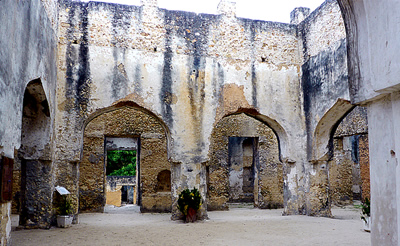 |
| Ruin of Omani Empire Palace |
The Omani empire in East Africa was based on the Swahili coast, which extended from present-day central Somalia to Cape Delgado in southern Mozambique. It included a number of islands and archipelagos in the Indian Ocean.
There were more than 400 urban settlements of varying sizes. The trading networks within the interior extended from 20 to 200 miles. The trade provided a valuable intermediary between the African interior and the vast Indian Ocean trade.
This lucrative trade had been disrupted by the arrival of the Portuguese after 1498. The non-Muslim Portuguese had interfered with the Muslim Swahili trading connections without offering security. Consequently they were attacked by the Turks by the coast and the Jagga and Zimba from the interior.
  |
Treasure hunts for gold and silver and slave-hunting expeditions disrupted the interior trade just as Portuguese opposition to Islam disrupted the Indian Ocean aspect of the trade. In the early 17th century, the cities sought liberation from Portugal and called in the Omanis from southeastern Arabia.
The Omanis were a good fit as they had been trading partners with the Swahili city-states for centuries, were fellow Muslims, and used the Arabic alphabet, as did the Swahili.
They had also been threatened by the Portuguese, who sought to control their strategic position of the Straits of Hormuz at the entrance of the Persian Gulf. Thus they were glad to arrive in the 1640s to attack the Portuguese.
Between 1640 and 1730, they conquered all of the Swahili cities from Somalia to the border between Tanganyika and Mozambique. By 1730, Zanzibar had emerged as the most important Swahili city and the Omanis and an Omani governor were established there.
But though the Omanis came as allies and liberators, they remained as conquerors through appointing representatives in each city. Over the next half-century, the Swahili cities grew tired of Omani taxes and there were periodic revolts.
There were temporary overthrows of Omani representatives, but these would be put down. The only city to regain authority was Mombassa under the Mazrui family. They were partially protected in their harbor by Fort St. Jesus, the fortress built by the Portuguese for their military headquarters.
During the 18th century, old trade patterns reemerged under Omani rule due to increased demand for slaves, the availability of capital from places such as India to finance trade, and the willingness of Africans in the interior to take slaves and ivory to the coast.
There were effects of the new emphasis on slaves, which replaced the earlier trade in gold (with Zimbabwe) and copper (from Katanga). The international trade for slaves made Omani sultans rich; it also turned communities against each other. Former African trading partners of the Swahili raided each other (encouraged by Omanis to take persons to sell as slaves).
Some of the smaller Swahili settlements disappeared as they were not defensible against voracious slave traders. Overall, the Swahili city-states did not regain the wealth that they had experienced during the golden era of 1300–1500.
Internally the people began to identify with Omani conquerors. Inside Swahili cities Omani soldiers of fortune expropriated large tracts of land although many were actually ethnic Baluchis. Many upper-class Swahili found it advantageous to intermarry with Omanis and even claim Arab ancestry.
These internal changes plus the participation of wealthy coastal people in the interior slave trade and the owning of slaves from the interior created a chasm between the coast and the interior that persists to this day.
By 1800, the Omani empire in East Africa faced new challenges as the English and French established themselves off East Africa in the Comoros and Madagascar (French), as well as Mauritius and Seychelles (English).